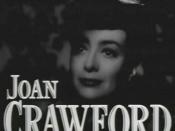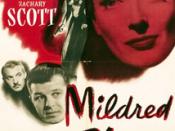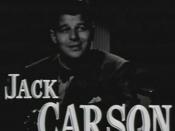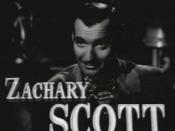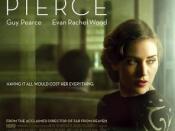There are a few themes that seem to be consistently analyzed in film, the two big ones being the nature of family and of sexuality. Dizzy damsels in distress, aging repressed patriarchs, trustworthy buddies, repressed housewives, fumbling villains- these are just some of the archetypes who are used to tell the filmÃÂs story. But as universal as these archetypes are, it is in the angle they are shown from and the way their story is told that truly defines the details of a film. Whether or not the view is a negative or positive one, for example makes a large difference in the film. Even more subtle then are in the tiny messages the characters carry. The lead female character, because of the very exhibitionist nature of femininity, is a primary tool in films to express fundamental themes and ideas in the narrative. In ÃÂThe Awful Truth,ÃÂ for example, a screwball remarriage comedy starring Cary Grant and Irene Dunne, DunneÃÂs character is representative of the fun and free world Grant cannot fundamentally accept.
The concentration on her beauty and general attractive nature makes the audience feel positive and her ending relationship with Grant lessens the importance of children in a family. Film noir heroines accomplish a very different end in that they are a manifestation of all of societyÃÂs greatest fears about Post-War loss of innocence. Sometimes, however, these genres and portrayals of specific characters are not so easy to label because the ideas behind them begin to blend into each other. Although Mildred Pierce is fundamentally, due to its stylistics and prominent themes, a film noir, itÃÂs remarriage comedy influences and strong maternal melodrama themes make put it in its own genre category. The whole ending of the movie, sans the successful conversation, leaves the unshakable taste of the remarriage comedy genre in oneÃÂs mouth. For example, the ending happiness of remarriage comedies is achieved through the man changing. In Mildred Pierce, Mildred is able to return to Bert after he gets a better job and is able to financially be her equal if not supporter, taking his appropriate role in the home.
The complicated nature of this film is made clear in its critique of capitalism and society in that while the message is fundamentally film noir, the execution is in the same style as the remarriage comedy and maternal melodrama. As in most film noirs, it is the heroine, Veda, whose desire for wealth destroys her and everyone around her. In Monte Beragon, Veda sees immediate opportunity to seduce the playboy, a man clearly weak for women, to get from him what she can. The scene is reminiscent of StellaÃÂs first meeting with Stephen Dallas in the famous maternal melodrama, ÃÂStella Dallas.ÃÂ Her first time sitting in StephenÃÂs office, she admires his fancy suite. That he owns an expensive suit immediately impresses Stella and reminds her of what Stephen can give her. Upon meeting Monte, Veda immediately comments on seeing him in all the society papers, a fact to her makes him upper class. This is slightly ironic considering one might believe someone in 1930ÃÂs upper class society would find someone written up regularly with other women in society papers as tacky. Throughout the film, Veda follows closely in the footsteps of Stella, mistaking her capitalist dream for the American dream, in that she puts all her faith in marrying a wealthy man to achieve her goals. One of film noirÃÂs principal uses was to reflect the tension between the alienation felt by returning soldiers in a world of growing industry. In Mildred Pierce, the success of MildredÃÂs business only leads to strengthen her feelings of loneliness and alienation. At the end of the film, with both film noir and maternal melodrama, society and bourgeoisie ideals are villains. Despite the strong critique of capitalism throughout the movie, the staunchly remarriage comedy genre ending, in which Mildred ends up with her first husband, Bert, is a reminder of the importance of work over building of a family. While MildredÃÂs business flourishes and gives her opportunity, her daughter Veda does nothing but take everything she can from her until she has nothing left.
That the films ends with Mildred remarrying her first husband is crucial in any analysis of Mildred PierceÃÂs strong deviation from typical film noirs. Film noir, in itself, is a genre that has also been referred to as the ÃÂrealistic melodrama,ÃÂ portraying the dismal fate of characters that still yearn for an integrated self and society. (Pg. 219, May) From this, it is not so far to think of Mildred Pierce as a form of melodrama in its own right. The maternal melodrama is largely about an underlying fear of motherhood as a state that can bring women no happiness. This is why in maternal melodramas, women are not meant to bond with their children in a way that satisfies their own needs. The fear manifested as reality in these films is that once the woman gives birth, she begins to desire her own repression. Mildred identifies herself at the beginning of the film, having already given birth to her daughters and describing herself first and foremost as a mother and wife who loved to live in the kitchen. This warning against motherhood is made particularly clear in Mildred Pierce, in which Bert grows away from Mildred due to her almost unhealthy attachment to her children. Literally, MildredÃÂs strong bond and satisfaction in motherhood interferes with her sexuality and therefore, her relationship with her husband. Mildred Pierce only deviates from the maternal melodrama in that it is, if possible, an even more negative outlook. In maternal melodramas, a motherÃÂs sacrifice, in the end, overwhelms the power of the Oedipal scenario encroaching upon them. In Mildred Pierce, however, even after Mildred offers herself to the patriarchal authorities over her daughter, she still is helpless to save her. The fundamental fear of motherhood is executed in a very distinct remarriage comedy ending, in which the married couples at the beginning of the movie gets divorced during it, but remarry in the end. Mildred is able to remarry her first husband now that he, the man, has changed and also because they are now both, essentially childless. In remarriage comedies, children are unimportant, a force which lessens the bond between the couple in question. Mildred and Bert initially divorce as a result of parenting disagreements, but are reunited when their children are all out of the picture. However, despite the clear influence of the remarriage comedy, the ending still keeps with the essentially film noir story in that the hero, Mildred, tries her best to survive successfully throughout film and after inevitable failure, retreats to the past (Bert).
Women are very easy to make interesting in films because of the very exhibitionist nature of femininity, making their differing portrayals in the different film genres highly indicative of the message meant to be sent by the film. Veda represents the archetypal noir heroine- beautiful, mysteriously seductive and apparently helpless, but really a cold manipulator on a quest for wealth and power. VedaÃÂs dark hybrid desires, associated with primitive traditions and inner repressions drive her to heinous crimes Mildred, in her analysis as a female film character, is very typical of maternal melodrama women in that she represents everywoman, hence why she must be punished for her transgressions. The narrative of Mildred Pierce could also be seen as a typically ÃÂfemaleÃÂ or ÃÂless linear narrativeÃÂ that encourages identification with the passive, suffering heroine and eventually emphasizes her failure. Mildred fails because in the end she is unable to either help Veda or change her for the better. Unlike in comedies and many thrillers, where lead characters go through a transformation, in melodramas, the characters are consistent. At the end of the film, even after reaching her lowest low and watching her mother attempt to sacrifice herself, Veda still treats Mildred coldly, showing she is still as selfish and manipulative as when the film began. The visual display of this is another minor way in which the film deviates toward the remarriage genre. While maternal melodramas only put emphasis on a womanÃÂs body as she goes through a metamorphosis, the remarriage comedy simply points to an emphasis on an active and beautiful womanÃÂs body, which Mildred and Veda consistently are. In a typical maternal melodrama reading of Mildred Pierce, one could read MildredÃÂs passive state as a result of her essentially castrated self. Somewhat like Helen in Stella Dallas, Veda is all-powerful and therefore represents the phallic. Another representation of the ÃÂphallic womanÃÂ in Mildred Pierce is Ida Corwin, who effaces her femininity to reach this state. Her femininity is more hidden and her general persona incorporates enough masculine characteristics that in the film she even complains of men looking at her like another man. Ida Corwin is a very significant character in the study of genre regarding Mildred Pierce because in typical film noir, there is a dysfunctional relationship between women. While this negative relationship is reflected in the primary all female relationship between Mildred and Veda, the relationship between Ida and Mildred and the maternal melodrama storyline, undercuts it. Mildred not only learns the restaurant business from Ida, but Ida also represents for her a positive image of a self-sufficient woman throughout a large chunk of her life. Therefore, despite this story about weak inter-female relations, there is still the relationship between Ida and Mildred, which give the only source of hope in the very dark world, which exists around Mildred.
BibliographyMay, Lary. The Big Tomorrow Hollywood and the Politics of the American Way. New York: University Of Chicago P, 2002.
